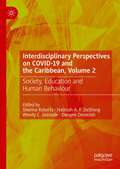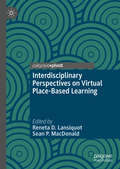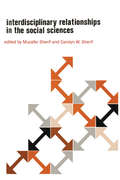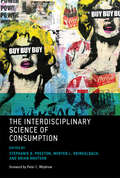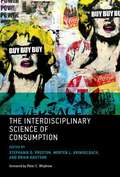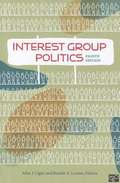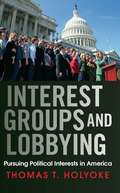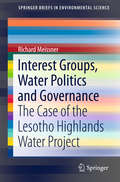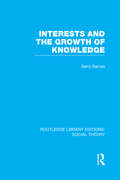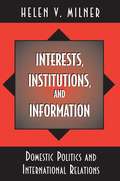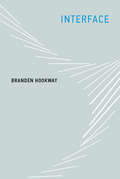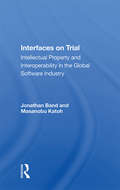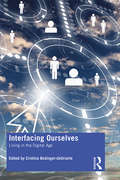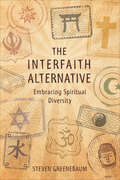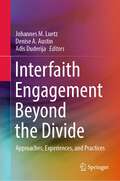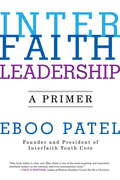- Table View
- List View
Interdisciplinary Perspectives on COVID-19 and the Caribbean, Volume 2: Society, Education and Human Behaviour
by Sherma Roberts Halimah A. F. DeShong Wendy C. Grenade Dwayne DevonishCaribbean countries have had to navigate multiple crises, which have tested their collective resolve through time. In this regard, the region’s landscape has been shaped by an interplay of vulnerability and resilience which has brought to the fore possibilities and contradictions. It is within this context that the effects of the COVID-19 pandemic must be considered. Interdisciplinary Perspectives on COVID-19 and the Caribbean, Volume 2: Society, Education and Human Behaviour provides a comprehensive, multi- and interdisciplinary assessment of the impact of the COVID-19 pandemic, using the Caribbean as the site of enquiry. The edited collection mobilises critical perspectives brought to bear on research produced within and beyond the boundaries and boundedness of conventional academic disciplinary divides, in response to the multi-dimensional crises of our time. This volume is divided into four (4) parts consisting of twenty-three (23) chapters and weaves together four broad thematic strands: COVID-19 and Caribbean Society; COVID-19 Religion and Rights; Psycho-social Impacts of COVID-19; and Education, Innovation, and Technology. Authors working within and across the human, social, physical and life sciences consider the myriad effects of the health crisis in the region, interrogating these experiences from the granular to macro level, utilising inter and multidisciplinary lenses. Collectively, the chapters which constitute Volume II expose the fault lines in Caribbean societies, which are deeply rooted in the region’s history and delineate the precise ways in which the pandemic has transformed lives and livelihoods in the region. The culmination of this collection offers a reimagining of our Caribbean contemporary futures in the hope of finding home-grown solutions, avenues and possibilities.
Interdisciplinary Perspectives on Virtual Place-Based Learning
by Reneta D. Lansiquot Sean P. MacDonaldThis book explores how virtual place-based learning and research has been interpreted and incorporated into learning environments both within and across disciplinary perspectives. Contributing authors highlight the ways in which they have employed a variety of methodologies to engage students in the virtual exploration of place. In the process, they focus on the approaches they have used to bring the real world closer through virtual exploration. Chapters examine how the resources of the urban environment have been tapped to design student research projects within the context of an interdisciplinary course. In this way, authors highlight how virtual place-based learning has employed the tools of mapping and data visualization, information literacy, game design, digital storytelling, and the creation of non-fiction VR documentaries. This book makes a valuable contribution to the literature, offering a model of how the study of place can be employed in creative ways to enhance interdisciplinary learning.
Interdisciplinary Relationships in the Social Sciences
by Muzafer Sherif Carolyn Wood SherifInterdisciplinary collaboration in the social sciences is obviously essential to scientifi c progress, but discontent and practical diffi culties hinder collaboration in research and training. Many of the problems arise from the failure in the separate disciplines to understand the basis on which collaboration is necessary and possible. In an eff ort to shed light on the situation, these original essays by eminent scholars-economists, geographers, psychologists, political scientists,sociologists, anthropologists, and others-demonstrate eff ective means of achieving interdisciplinary coordination in studying human behavior and delineating promising areas-for cooperative research. Th e book provides a sophisticated guide to the nature of knowledge in social science as applied to its core disciplines.
The Interdisciplinary Science of Consumption (The\mit Press Ser.)
by Stephanie D. Preston Morten L. Kringelbach Brian KnutsonScholars from psychology, neuroscience, economics, animal behavior, and evolution describe the latest research on the causes and consequences of overconsumption.Our drive to consume—our desire for food, clothing, smart phones, and megahomes—evolved from our ancestors' drive to survive. But the psychological and neural processes that originally evolved to guide mammals toward resources that are necessary but scarce may mislead us in modern conditions of material abundance. Such phenomena as obesity, financial bubbles, hoarding, and shopping sprees suggest a mismatch between our instinct to consume and our current environment. This volume brings together research from psychology, neuroscience, economics, marketing, animal behavior, and evolution to explore the causes and consequences of consumption. Contributors consider such topics as how animal food-storing informs human consumption; the downside of evolved “fast and frugal” rules for eating; how future discounting and the draw toward immediate rewards influence food consumption, addiction, and our ability to save; overconsumption as social display; and the policy implications of consumption science.Taken together, the chapters make the case for an emerging interdisciplinary science of consumption that reflects commonalities across species, domains, and fields of inquiry. By carefully comparing mechanisms that underlie seemingly disparate outcomes, we can achieve a unified understanding of consumption that could benefit both science and society.
The Interdisciplinary Science of Consumption
by Stephanie D. Preston Peter C. Whybrow Morten L. Kringelbach Brian KnutsonOur drive to consume -- our desire for food, clothing, smart phones, and megahomes -- evolved from our ancestors' drive to survive. But the psychological and neural processes that originally evolved to guide mammals toward resources that are necessary but scarce may mislead us in modern conditions of material abundance. Such phenomena as obesity, financial bubbles, hoarding, and shopping sprees suggest a mismatch between our instinct to consume and our current environment. This volume brings together research from psychology, neuroscience, economics, marketing, animal behavior, and evolution to explore the causes and consequences of consumption. Contributors consider such topics as how animal food-storing informs human consumption; the downside of evolved "fast and frugal" rules for eating; how future discounting and the draw toward immediate rewards influence food consumption, addiction, and our ability to save; overconsumption as social display; and the policy implications of consumption science.Taken together, the chapters make the case for an emerging interdisciplinary science of consumption that reflects commonalities across species, domains, and fields of inquiry. By carefully comparing mechanisms that underlie seemingly disparate outcomes, we can achieve a unified understanding of consumption that could benefit both science and society.
Interdisziplinäre Architektur-Wissenschaft: Eine Einführung (Interdisziplinäre Architektur-Wissenschaft: Praxis – Theorie – Methodologie – Forschung)
by Karsten Berr Achim HahnArchitektur, sichtbar und anschaulich, gestaltet baulich-technisch und räumlich unsere Lebensumwelt und stellt in dieser genuinen Eigenschaft eine besondere Herausforderung an die Wissenschaft(en) dar.Bei den versammelten Beiträgen dieses Bandes handelt es sich um die schriftlichen Fassungen von Vorträgen im Rahmen eines von der DFG finanzierten ‚Rundgesprächs‘ zum Thema ‚Interdisziplinäre Architektur-Wissenschaft‘ im Juni 2018 an der Technischen Universität Dresden – ergänzt von weiteren Autorinnen und Autoren.Der Band ist in vier thematische Schwerpunkte gegliedert. Der erste Teil präsentiert philosophische Grundlagen einer interdisziplinären Architektur-Wissenschaft. Der zweite Teil stellt aus unterschiedlichen disziplinären oder wissenschaftstheoretischen Ansätzen heraus wissenschaftstheoretische und methodologische Grundlagen und Zugriffe bereit. Der dritte Teil beleuchtet das Spannungsverhältnis von Architektur als Disziplin und Praxis zu Architekturtheorie und Architektur-Wissenschaft. Im vierten Teil werden exemplarisch Theoriebildung und Theorien zu Landschaft, Landschaftsforschung und Landschaftsarchitektur diskutiert.
Interdisziplinäre Kreuzungen: Soziologie – Anthropologie – Geschichte
by Wolfgang EßbachDie Aufforderung, über den Tellerrand des eigenen Faches hinauszuschauen, die Einsicht, daß sich nicht unbedingt im Zentrum, sondern an den Rändern von Fächern neuartige Fragen stellen, und die Klagen über den Fachidiotismus sind wohlbekannt. Der geflügelte Spruch des Dichters Jean Paul: „Jeder Fachmann ist in seinem Fach ein Esel“ trifft auch Nur-Soziologen, die nichts von ihrem Fach wissen, wenn sie sich nicht in der Landschaft auskennen, die ihre Disziplin umgibt. Ihre späte Akademisierung hat der Soziologie eine schöne Vielfalt von angrenzenden Nachbarschaften beschert. Dieser Band handelt von Kreuzungen zwischen Soziologie, Anthropologie und Geschichte. In den Studien geht es unter anderem um historische Quellen soziologischen Denkens, um die Erforschung von Biografien, um kulturelle Identität und Migration, die Problemgeschichte der Anthropologie, um Gabe und Rache, um den Ort der Phänomenologie in der Soziologie und Anthropologie artifizieller Lebenswelt, um Postmoderne als Gegenwart oder Epoche, die Begrenzungen des Historismus, das Verhältnis von Subjektivierungsweise und Geschichte, die soziale Funktion von Vergangenheitsrepräsentation und die Frage: Welche Vergangenheit brauchen unsere Kinder?Der Band versammelt Schriften Wolfgang Eßbachs zum inter- und transdisziplinären Verhältnis von Soziologie, Anthropologie, Geschichte und wie sie sich gegenseitig befruchten können.
Interessen und Interessierung: Das Interessenkonzept in der Sozialtheorie
by Thomas HaipeterDieses Buch handelt von Interessen und ihrer Rolle im sozialen Handeln. Was sind Interessen, wie entstehen sie, und wie werden sie im sozialen Handeln praktisch wirksam? Und in welchen Beziehungen stehen Interessen zu anderen Handlungsorientierungen wie Werten oder Emotionen – wann handeln soziale Akteure aus Interesse, und wann folgen sie anderen Zielen? Diese Fragen sind von einiger Bedeutung, denn Interessen gelten in vielen Theorieansätzen der Soziologie als eines der zentralen Motive, die Menschen dazu bringen, sozial zu handeln und auf diese Weise soziale Tatbestände zu erzeugen. Trotz ihrer Bedeutung sind Interessen als Konzept jedoch nur selten reflektiert worden; explizite Auseinandersetzungen damit sind in der soziologischen Theorie kaum zu finden. Deshalb soll in diesem Buch der Interessenbegriff genauer ausgeleuchtet werden. Dazu wird der Frage nachgegangen, wie der Interessenbegriff in den verschiedenen Traditionen der Sozialtheorie vom Funktionalismus bis zum Neomarxismus verwendet wird. Daran anschließend wird der Versuch unternommen, Interessen in ihrem multidimensionalen und prozesshaften Charakter als „Interessierung“ neu zu fassen und in ihren Implikationen für Theoriebildung und empirische Forschung der Soziologie greifbar zu machen.
Interessenorganisation: Begriffsbestimmung, Definition und Typologie (essentials)
by Deniz Z. ErtinDas vorliegende Buch beschäftigt sich mit der Begriffsbestimmung und Definition von Interessenorganisationen. Dabei wird die Nutzung unterschiedlicher Begriffe in der deutschen und englischen politikwissenschaftlichen Literatur diskutiert. Des Weiteren werden auch die begriffsgeschichtlichen und theoretischen Aspekte dieser Begriffe erläutert und ausgeführt. Neben der Definition des Begriffs werden auch die verschiedenen Typologien von Interessenorganisation untersucht und differenziert. Anhand von praktischen Beispielen werden diese Typologien diskutiert und angewendet.
Interest Group Politics
by Allan J. Cigler Burdett A. LoomisAfter a turbulent and moneyed midterm election season, turn to the new edition of this trusted classic to guide your students through the influence and reach of interest groups. With its broad spectrum of scholarship on interest groups past and present, Interest Group Politics once again brings together noted political scientists to provide comprehensive coverage and cutting-edge research on interest groups in U. S. politics. Contributors examine the growth of social networks in lobbying, the actions of organized interests during the health care reform debate, campaign mobilization and congressional decision making from the group perspective, and more.
Interest Groups and Campaign Finance Reform in the United States and Canada
by Robert G. BoatrightIn the early 2000s, the United States and Canada implemented new campaign finance laws restricting the ability of interest groups to make political contributions and to engage in political advertising. Whereas both nations' legislative reforms sought to reduce the role of interest groups in campaigns, these laws have had opposite results in the two nations. In the United States, interest groups remained influential by developing broad coalitions aimed at mobilizing individual voters and contributors. In Canada, interest groups largely withdrew from election campaigns, and, thus, important voices in elections have gone silent. Robert G. Boatright explains such disparate results by placing campaign finance reforms in the context of ongoing political and technological changes.
Interest Groups and Experimentalist Governance in the EU: New Modes of Lobbying (Palgrave Studies in European Political Sociology)
by Douwe TruijensThis book researches the role that interest groups play in new modes of EU governance, with a specific focus on the role of interest representation in experimentalist governance frameworks. The research asks how lobbying in the legislative process contributes to the governance framework and its institutional arrangements and subsequently asks how the relevant interest groups participate in policy implementation – in which broad policy goals are concretised. The research is based on four in-depth case studies: the Industrial Emissions Directive, the General Data Protection Regulation, the Combating Child Abuse Directive, and the Institutions for Occupational Retirement Provision Directive. Of special interest in these cases are the balance between types of interest groups (most notably business and NGOs) in policy formulation and implementation, and the changing dynamics between interest groups and public policy-makers in such ‘horizontal’ governance. The book’s findings are required reading for all those concerned with effective and democratic policy-making in the EU.
Interest Groups and Lobbying
by Thomas T. HolyokeInterest groups and lobbyists play a crucial role in how public policy is made in the United States’ representative democracy. By helping citizens organize and pursue their self-interests in the political arena, interest groups and lobbyists are an alternative but very effective form of representation. However, the adversarial nature of interest groups often fuels voter discomfort with the political process. Interest Groups and Lobbying is an accessible and comprehensive text that examines the crux of this conflict. Pulling together two areas of interest group research--why advocacy organizations form and how they are able to gain influence in Washington, DC--Thomas T. Holyoke shows students the inner workings of interest groups in the United States. Using case studies to clarify and expand on the issues surrounding lobbying and group action in federal, state, and local government, Holyoke explores how we can use interest groups and their adversarial impulse to achieve the greatest good for the greatest number of people.
Interest Groups, Water Politics and Governance
by Richard MeissnerThe book investigates the role interest groups have played over the years to influence the governments of Lesotho and South Africa, the World Bank and project implementation authorities in changing some policy aspects of the Lesotho Highlands Water Project (LHWP). Some of the issues being agitated by the interest groups are the resettlement of villagers where some of the dams for the projects are being constructed. The author argues that interest groups and individuals have the ability to influence the above-mentioned institutions and to such an extent that water politics and governance is not the domain of state institutions only.
Interests and the Growth of Knowledge (Routledge Library Editions: Social Theory)
by Barry BarnesIntriguingly different in approach from conventional works in the same area of inquiry, this study deals with the central problems and concerns of the sociology of knowledge as it has traditionally been conceived of. In other words, it is concerned with the relationship of knowledge, social interests and social structure, and with the various attempts which have been made to analyse the relationship. Barry Barnes takes the classic writings in the sociology of knowledge – by Marx, Lukács, Weber, Mannheim, Goldmann, Habermas and others – and uses them as resources in coming to grips with what he regards as the currently most interesting and significant questions in this area. This approach reflects one of the principal themes of the book itself. Knowledge, it is argued, is best treated as a resource available to those possessing it. This is the best perspective from which to understand its relationship to action and its historical significance; it is a perspective which avoids the problems of holding that knowledge is derivative, as well as those generated by the view that knowledge is a strong determinant of consciousness. the result is an unusual textbook, particularly valuable when read in conjunction with the original works it discusses.
Interests, Institutions, and Information: Domestic Politics and International Relations
by Helen V. MilnerIncreasingly scholars of international relations are rallying around the idea that "domestic politics matters." Few, however, have articulated precisely how or why it matters. In this significant book, Helen Milner lays out the first fully developed theory of domestic politics, showing exactly how domestic politics affects international outcomes. In developing this rational-choice theory, Milner argues that any explanation that treats states as unitary actors is ultimately misleading. She describes all states as polyarchic, where decision-making power is shared between two or more actors (such as a legislature and an executive). Milner constructs a new model based on two-level game theory, reflecting the political activity at both the domestic and international levels. She illustrates this model by taking up the critical question of cooperation among nations. Milner examines the central factors that influence the strategic game of domestic politics. She shows that it is the outcome of this internal game--not fears of other countries' relative gains or the likelihood of cheating--that ultimately shapes how the international game is played out and therefore the extent of cooperative endeavors. The interaction of the domestic actors' preferences, given their political institutions and levels of information, defines when international cooperation is possible and what its terms will be. Several test cases examine how this argument explains the phases of a cooperative attempt: the initiation, the negotiations at the international level, and the eventual domestic ratification. The book reaches the surprising conclusion that theorists--neo-Institutionalists and Realists alike--have overestimated the likelihood of cooperation among states.
Interface (The\mit Press Ser.)
by Branden HookwayA cultural theory of the interface as a relation that is both ubiquitous and elusive, drawing on disciplines from cultural theory to architecture.In this book, Branden Hookway considers the interface not as technology but as a form of relationship with technology. The interface, Hookway proposes, is at once ubiquitous and hidden from view. It is both the bottleneck through which our relationship to technology must pass and a productive encounter embedded within the use of technology. It is a site of contestation—between human and machine, between the material and the social, between the political and the technological—that both defines and elides differences.A virtuoso in multiple disciplines, Hookway offers a theory of the interface that draws on cultural theory, political theory, philosophy, art, architecture, new media, and the history of science and technology. He argues that the theoretical mechanism of the interface offers a powerful approach to questions of the human relationship to technology. Hookway finds the origin of the term interface in nineteenth-century fluid dynamics and traces its migration to thermodynamics, information theory, and cybernetics. He discusses issues of subject formation, agency, power, and control, within contexts that include technology, politics, and the social role of games. He considers the technological augmentation of humans and the human-machine system, discussing notions of embodied intelligence.Hookway views the figure of the subject as both receiver and active producer in processes of subjectification. The interface, he argues, stands in a relation both alien and intimate, vertiginous and orienting to those who cross its threshold.
Interface
by Branden HookwayIn this book, Branden Hookway considers the interface not as technology but as a form of relationship with technology. The interface, Hookway proposes, is at once ubiquitous and hidden from view. It is both the bottleneck through which our relationship to technology must pass and a productive encounter embedded within the use of technology. It is a site of contestation -- between human and machine, between the material and the social, between the political and the technological -- that both defines and elides differences. A virtuoso in multiple disciplines, Hookway offers a theory of the interface that draws on cultural theory, political theory, philosophy, art, architecture, new media, and the history of science and technology. He argues that the theoretical mechanism of the interface offers a powerful approach to questions of the human relationship to technology. Hookway finds the origin of the term interface in nineteenth-century fluid dynamics and traces its migration to thermodynamics, information theory, and cybernetics. He discusses issues of subject formation, agency, power, and control, within contexts that include technology, politics, and the social role of games. He considers the technological augmentation of humans and the human-machine system, discussing notions of embodied intelligence. Hookway views the figure of the subject as both receiver and active producer in processes of subjectification. The interface, he argues, stands in a relation both alien and intimate, vertiginous and orienting to those who cross its threshold.
Interface between English Language Education Policies and Practice: Examples from Various Contexts
by Eric Enongene Ekembe Lauren Harvey Eric DwyerThis book is about the policy-practice praxis in English language education, and draws on research from a diverse range of under-explored international settings to showcase the importance of contextual realities on how policy and practice interact. The case studies covered in the volume come from five continents (Africa, Europe, Asia, and South and North America) and cover 11 countries in total. The authors cover a wide range of themes and identify a number of issues at the interface between policy and practice. In some cases they also highlight local initiatives for navigating these issues, providing contextually-grounded guidance and experience which will be of use to teachers and teacher trainers in other settings. This book will be of interest to policy makers, EMI researchers, ELT practitioners, teacher trainers and trainees, and the broader Applied Linguistics research community.
Interfaces for Ground and Air Military Robots: WORKSHOP SUMMARY
by National Research Council of the National AcademiesThe National Academies Press (NAP)--publisher for the National Academies--publishes more than 200 books a year offering the most authoritative views, definitive information, and groundbreaking recommendations on a wide range of topics in science, engineering, and health. Our books are unique in that they are authored by the nation's leading experts in every scientific field.
Interfaces On Trial: Intellectual Property And Interoperability In The Global Software Industry (The\information Society Ser.)
by Jonathan BandThis book presents the history of one of the key debates in the continuing effort to develop a legal framework for intellectual property rights in the burgeoning computer software industry. It is the first full account of the interoperability debate-the controversy over the protectability of interface specifications and the permissibility of
Interfacing Ourselves: Living in the Digital Age
by Cristina Bodinger-DeUriarteInterfacing Ourselves consists of new work that examines digital life on three levels: individuals and digital identity; relationships routinely intertwining digital and physical connections; and broader institutional and societal realities that define the context of living in the digital age. A key focus is what it means in varied social arenas when most individuals live as co-present or multi-present—simultaneously engaged in digital and physical space—alone and with others. Topics include how: digital life contributes to well-being; individuals experience digital dependency; a smartphone is more than a smartphone; netiquette reveals social change; some online communities become prosocial salient havens while others reinforce social inequality; Millennials build intimacy; Latinx do familismo; and digital surveillance and big data redefine consumerism, advocacy, and civic engagement. Six chapters incorporate insights from hourly journals of Millennials undergoing a period of digital abstinence. Other chapters draw from surveys, digital auto-ethnography, content analysis, and other methods to explore digital life at the level of individual and interactive experience, and at a broader institutional and societal level. Ultimately, the book presents the need for living a mindful digital life by developing greater awareness as an individual, a social being, and a netizen and citizen.
The Interfaith Alternative: Embracing Spiritual Diversity
by Steven GreenebaumWhatever your spiritual path, chances are that the primary tenets of your faith include universal love, acceptance, and compassion. Yet three thousand years after Moses, twenty-five hundred years after the Buddha, two thousand years after Jesus, and fifteen hundred years after Muhammad, we are still divided by our differences. Religious intolerance, discrimination, even persecution and violence make up the not-so-golden rule. The Interfaith Alternative shows us how we can celebrate each other without fear of losing our own identity. It illuminates the path to creating a nurturing spiritual community that honors and includes all religious languages--an alternative to Jews worshiping only with Jews, Christians with Christians, and Muslims with Muslims. In doing so, it demonstrates that through coming together in a mutually supportive environment we can concentrate on our shared desire to remake the world into a compassionate, loving place. At its core, Interfaith is about community and justice. Once we truly embrace diversity, we embrace our common humanity. A powerful antidote to the current climate of fear and mistrust, The Interfaith Alternative argues that it is not how we encounter the sacred, but what we do about it that counts--there are positive alternatives to religious lines in the sand. Steven Greenebaum is an Interfaith minister whose experiences directing choirs of different faiths and denominations have helped him to understand the profound wisdom of many spiritual traditions. Steven has dedicated his life to working for social and environmental justice. He is the founder of the Living Interfaith Church in Lynnwood, Washington.
Interfaith Engagement Beyond the Divide: Approaches, Experiences, and Practices
by Johannes M. Luetz Denise A. Austin Adis DuderijaThis book features reflections by scholars and practitioners from diverse religious traditions. It posits that the global challenges facing humanity today can only be mastered if humans from diverse faith traditions can meaningfully collaborate in support of human rights, reconciliation, sustainability, justice, and peace. Seeking to redress common distortions of religious mis- and dis-information, the book aims to construct interreligious common ground ‘beyond the divide’.Organised into three main sections, the book features sixteen conceptual, empirical, and practice-informed chapters that explore spirituality across faiths and cultures. Chapter 1 delineates the state of the art in relation to interfaith engagement, Chapters 2–8 advance theoretical research, Chapters 9–12 discuss empirical perspectives, and Chapters 13–16 showcase field projects and recount stories and lived experiences.Comprising works by scholars, professionals, and practitioners from around the globe, Interfaith Engagement Beyond the Divide: Approaches, Experiences, and Practices is an interdisciplinary publication on interreligious thought and engagement:Assembles a curated collection of chapters from numerous countries and diverse religious traditions;Addresses interfaith scholarship and praxis from a range of interdisciplinary perspectives;Comprises interfaith dialogue and collaborative research involving authors of different faiths;Envisions prospects for peace, interreligious harmony in diversity, and a world that may be equitably and enduringly shared.The appraisal of present and future challenges and opportunities, framed within a context of public policy and praxis, makes this interdisciplinary publication a useful tool for teaching, research, and policy development. Chapter 16 is available open access under a Creative Commons Attribution 4.0 International License via link.springer.com.
Interfaith Leadership: A Primer
by Eboo PatelA guide for students, groups, and organizations seeking to foster interfaith dialogue and promote understanding across religious linesIn this book, renowned interfaith leader Eboo Patel offers a clear, detailed, and practical guide to interfaith leadership, illustrated with compelling examples. Patel explains what interfaith leadership is and explores the core competencies and skills of interfaith leadership, before turning to the issues interfaith leaders face and how they can prepare to solve them. Interfaith leaders seek points of connection and commonality--in their neighborhoods, schools, college campuses, companies, organizations, hospitals, and other spaces where people of different faiths interact with one another. While it can be challenging to navigate the differences and disagreements that can arise from these interactions, skilled interfaith leaders are vital if we are to have a strong, religiously diverse democracy. This primer presents readers with the philosophical underpinnings of interfaith theory and outlines the skills necessary to practice interfaith leadership today.
